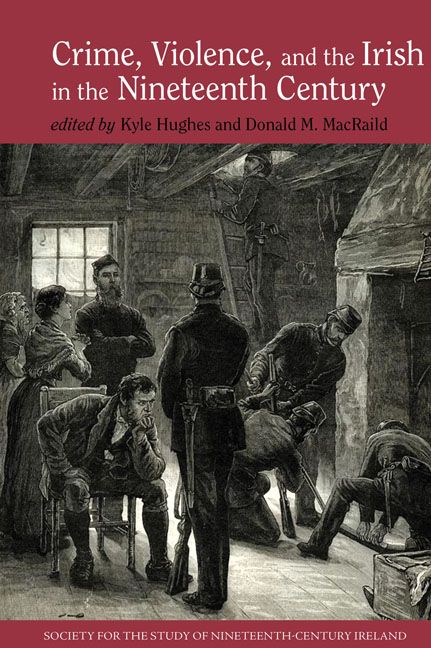Book contents
- Frontmatter
- Contents
- List of Illustrations
- List of Contributors
- Introduction: Crime, Violence, and the Irish in the Nineteenth Century; Themes and Perspectives
- Section 1 ‘Secret Societies’ and Collective Violence
- Section 2 The Law and its Responses
- 5 Cork's Courthouses, the Landed Elite, and the Rockite Rebellion: Architectural Responses to Agrarian Violence, 1820–1827
- 6 Constitutional Rhetoric as Legal Defence: Irish Lawyers and the Languages of Political Dissent in 1848
- 7 ‘Why, it's like a ’98 trial’: The Irish Judiciary and the Fenian Trials, 1865–1866
- 8 Crime and Punishment: Whiteboyism and the Law in Late Nineteenth-Century Ireland
- Section 3 Sectarianism and Violence
- Section 4 Manifestations of Crime and Violence
- Index
5 - Cork's Courthouses, the Landed Elite, and the Rockite Rebellion: Architectural Responses to Agrarian Violence, 1820–1827
from Section 2 - The Law and its Responses
- Frontmatter
- Contents
- List of Illustrations
- List of Contributors
- Introduction: Crime, Violence, and the Irish in the Nineteenth Century; Themes and Perspectives
- Section 1 ‘Secret Societies’ and Collective Violence
- Section 2 The Law and its Responses
- 5 Cork's Courthouses, the Landed Elite, and the Rockite Rebellion: Architectural Responses to Agrarian Violence, 1820–1827
- 6 Constitutional Rhetoric as Legal Defence: Irish Lawyers and the Languages of Political Dissent in 1848
- 7 ‘Why, it's like a ’98 trial’: The Irish Judiciary and the Fenian Trials, 1865–1866
- 8 Crime and Punishment: Whiteboyism and the Law in Late Nineteenth-Century Ireland
- Section 3 Sectarianism and Violence
- Section 4 Manifestations of Crime and Violence
- Index
Summary
The study of architectural history has been fertile ground for revisionist approaches in recent years. In particular, the concept that the neo-classical style of architecture, in ascendancy in late eighteenthand early nineteenth-century Europe, should be understood as the language of a small coterie of international cultural and economic elites, has come under sustained criticism. As Kathleen James-Chakraborty comments, a shift of focus from the ‘production’ to the ‘consumption’ of neo-classical architecture (though the argument could as well be applied to any other architectural style) has revealed counter-narratives that highlight aspects of material culture, class, and gender, all previously under-researched. Far from the preserve of an aristocratic elite, as Conor Lucey and Andrew Tierney have shown in their respective case-studies, the adoption of neo-classical architecture in Ireland formed part of a demarcation of class bound up with concepts of expressing or appropriating ‘politeness’ and ‘gentility’. The great economic and technological advances of the period, coupled with the availability of new ‘faux’ building materials such as Coade stone and a more vigorous print culture, led to an emboldened and discerning middle class of architectural patrons at the same time as the financial cost of emulating ‘elite’ neo-classical began to fall.
Nonetheless, it is an unavoidable fact that the landed elite in Ireland at the dawn of the nineteenth century were still the great patrons of architecture, and while their monopoly was broken, there was still an agenda of ‘politeness’ that they could control. The country house, especially from the period c.1750 to c.1830, marks the most compelling instance of the conspicuous consumption of neo-classical architecture by the Irish landed elite. Furthermore, scholars have highlighted the economic advantages of the eighteenth-century concept of ‘improvement’, the desire to follow European trends, and the competitive elements of ‘fashion’ and ‘taste’. There has been less agreement, perhaps unsurprisingly, about the political meaning of these buildings and how they reshaped landscapes: Roy Foster argues that the Irish landed elite, conscious of both their inferiority to their British aristocratic peers, and aware of their tenuous and relatively recent hold over their estates, engaged in an atavistic and ostentatious display of material culture to compensate for their unsure positions in Irish society. Foster considers that it was a desire to put ‘their mark on a landscape only recently won and insecurely held’.
- Type
- Chapter
- Information
- Crime, Violence and the Irish in the Nineteenth Century , pp. 87 - 111Publisher: Liverpool University PressPrint publication year: 2017



